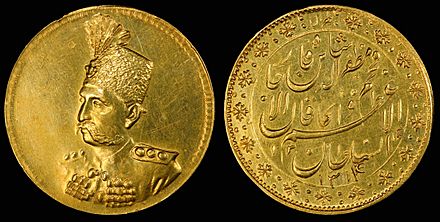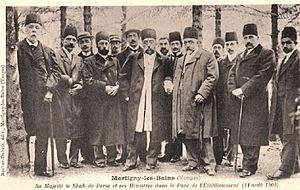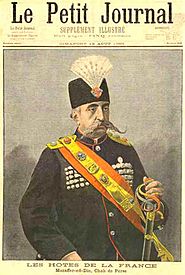Mozaffar ad-Din Shah Qajar facts for kids
Quick facts for kids Mozaffar ad-Din Shah Qajar |
|||||
|---|---|---|---|---|---|
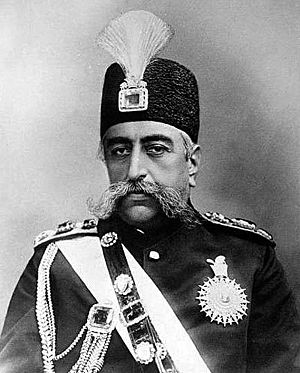
King of Persia Mozaffar ad-Din Shah Qajar in 1906
|
|||||
| Shah of Iran | |||||
| Reign | 1 May 1896 – 3 January 1907 | ||||
| Predecessor | Naser al-Din Shah Qajar | ||||
| Successor | Mohammad Ali Shah Qajar | ||||
| Prime Minister | Mirza Nasrullah Khan | ||||
| Born | 23 March 1853 Tabriz, Persia |
||||
| Died | 3 January 1907 (aged 53) Tehran, Persia |
||||
| Burial | Imam Hussein Shrine | ||||
| Spouse | Taj ol-Molouk | ||||
| Issue | See below | ||||
|
|||||
| Dynasty | Qajar | ||||
| Father | Naser al-Din Shah | ||||
| Mother | Shokouh al-Saltaneh | ||||
| Religion | Shia Islam | ||||
| Tughra |  |
||||
Mozaffar ad-Din Shah Qajar (Persian: مظفرالدین شاه قاجار, romanized: Mozaffar ad-Din Ŝāh-e Qājār; 23 March 1853 – 3 January 1907), was the fifth shah of Qajar Iran, reigning from 1896 until his death in 1907. He is often credited with the creation of the Persian Constitution of 1906, which he approved of as one of his final actions as Shah.
Biography
The son of the Qajar ruler Naser al-Din Shah Qajar, Mozaffar al-Din was named crown prince and sent as governor to the northern province of Azerbaijan in 1861. He spent his 35 years as crown prince in the pursuit of pleasure; his relations with his father were frequently strained, and he was not consulted in important matters of state. Thus, when he ascended the throne in May 1896, he was unprepared for the burdens of office.
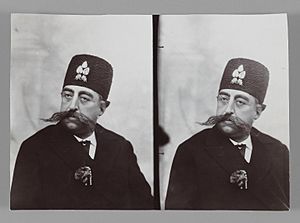
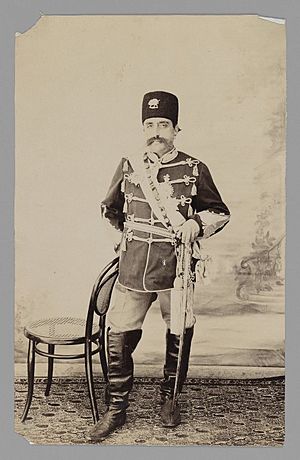
At Mozaffar al-Din's accession Persia faced a financial crisis, with annual governmental expenditures far in excess of revenues as a result of the policies of his father. During his reign, Mozzafar ad-Din attempted some reforms of the central treasury; however, the previous debt incurred by the Qajar court, owed to both England and Russia, significantly undermined this effort. He furthered this debt by borrowing even more funds from Britain, France, and Russia. The income from these later loans was used to pay earlier loans rather than create new economic developments. In 1908, oil was discovered in Persia but Mozzaffar ad-Din had already awarded William Knox D'Arcy, a British subject, the rights to oil in most of the country in 1901.
Like his father he visited Europe three times. During these periods, on the encouragements of his chancellor Amin-os-Soltan, he borrowed money from Nicholas II of Russia to pay for his extravagant traveling expenses. During his first visit he was introduced to the "cinematographe" in Paris, France. Immediately falling in love with the silver screen the Shah ordered his personal photographer to acquire all the equipment and knowledge needed to bring the moving picture to Persia, thus starting Persian cinema. The following is a translated excerpt from the Shah's diary:
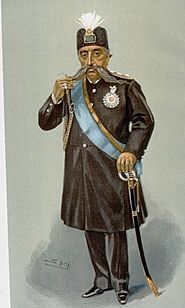
Additionally, in order to manage the costs of the state and his extravagant personal lifestyle Mozzafar ad-din Shah decided to sign many concessions, providing foreigners with monopolistic control of various Persian industries and markets. One example was the D'Arcy Oil Concession.
Widespread fears amongst the aristocracy, educated elites, and religious leaders about the concessions and foreign control resulted in some protests in 1906. These resulted in the Shah accepting a suggestion to create a Majles (National Consultative Assembly) in October 1906, by which the monarch's power was curtailed as he granted a constitution and parliament to the people. He died of a heart attack 40 days after granting this constitution and was buried in Imam Husayn Shrine in Kerbala.
Children
Sons
- Prince Mohammad-Ali Mirza E’tezad es-Saltaneh, later Mohammad-Ali Shah (1872–1925)
- Prince Malek-Mansur Mirza Shoa os-Saltaneh (1880–1920)
- Prince Abolfath Mirza Salar od-Dowleh (1881–1961)
- Prince Abolfazl Mirza Azd os-Sultan (1882–1970)
- Prince Hossein-Ali Mirza Nosrat os-Saltaneh (1884–1945)
- Prince Nasser-od-Din Mirza Nasser os-Saltaneh (1897–1977)
Daughters
- Princess Fakhr os-Saltaneh (1870 – ?) married Abdol Majid Mirza Eyn od-Dowleh
- Princess Ehteram os-Saltaneh (1871 – ?) married Morteza-Qoli Khan Hedayat Sani od-Dowleh
- Princess Ezzat od-Dowleh (1872 – 1955) married Abdol Hossein Mirza Farmanfarma
- Princess Shokuh os-Saltaneh (1880 – ?)
- Princess Shokuh od-Dowleh (1883 – ?)
- Princess Fakhr-od-Dowleh (1883 – 1955) mother of Ali Amini
- Princess Aghdas od-Dowleh (1891 – ?)
- Princess Anvar od-Dowleh (1896 – ?) married eghtedar es-Saltaneh son of Kamran Mirza
- Princess Ameneh Bratz (1930-1940)
List of premiers
- Mirza Ali-Asghar Khan Amin os-Soltan (till November 1896) (1st time)
- Post vacant (November 1896 – February 1897)
- Ali Khan Amin od-Dowleh (February 1897 – June 1898)
- Mirza Ali-Asghar Khan Amin os-Soltan (June 1898 – 24 January 1904) (2nd time)
- Prince Abdol-Majid Mirza Eyn od-Dowleh (24 January 1904 – 5 August 1906)
- Mirza Nasrollah Khan Ashtiani Moshir od-Dowleh (1906 – 18 February 1907)
Historical anecdotes
The Shah visited the United Kingdom in August 1902 with the anticipation of also receiving the Order of the Garter as it had been previously given to his father, Nasser-ed-Din Shah. King Edward VII refused to give this high honor to a non-Christian. Lord Lansdowne, the Foreign Secretary, had designs drawn up for a new version of the Order, without the Cross of St. George. The King was so enraged by the sight of the design, though, that he threw it out of his yacht's porthole. However, in 1903, the King had to back down and the Shah was appointed a member of the Order.
A nephew of his wife was Mohammed Mossadeq, the Prime Minister of Iran during the Pahlavi dynasty. Mossadeq was overthrown by a coup d'état staged by the United Kingdom and the United States in 1953.
Honours
- Austria-Hungary:
- Grand Cross of the Imperial Order of Leopold, 1894
- Grand Cross of the Royal Hungarian Order of Saint Stephen, in Brilliants, 1899
- Belgium: Grand Cordon of the Order of Leopold (military), in Brilliants, 1903
- France: Grand Cross of the National Order of the Legion of Honour, 1903
- Kingdom of Prussia:
- Knight of the Order of the Black Eagle, in Brilliants, 29 May 1902 – during the visit to Berlin of the Shah
- Grand Ceoss of the Order of the Red Eagle, 29 May 1902
- Kingdom of Italy:
- Knight of the Supreme Order of the Most Holy Annunciation, May 1902 – during the visit to Rome of the Shah
- Grand Cross of the Order of Saints Maurice and Lazarus, 1903
- Netherlands: Grand Cross of the Order of the Netherlands Lion, 1900
- Ottoman Empire:
- Hanedan-i-Ali-Osman Nishani, 1900
- Nishan-i-Imtiaz, 1900
- Kingdom of Romania: Grand Cross of the Order of the Star of Romania, in Brilliants, 23 May 1906
- Russian Empire:
- Knight of the Order of Saint Andrew the Apostle the First-called, 1902
- Knight of the Imperial Order of Saint Alexander Nevsky, 1902
- Knight of the Imperial Order of the White Eagle, 1902
- Knight of the Imperial Order of Saint Stanislaus, 1st Class, 1902
- Knight of the Imperial Order of Saint Anna, 1st Class in Brilliants, 1902
- Spain: Knight of the Order of the Golden Fleece, 6 September 1902 – from special envoys of the Spanish King visiting the Shah while he was in Paris during his European tour
- United Kingdom: Stranger Knight of the Most Noble Order of the Garter (KG), 16 February 1903
See also
 In Spanish: Mozaffareddín Shah Qayar para niños
In Spanish: Mozaffareddín Shah Qayar para niños
- Qajar dynasty
- Qajar family tree
- D'Arcy Concession
- Persian Constitutional Revolution
- Persian Constitution of 1906
- Anglo-Russian Entente
- Kamal ol-Molk
- Baghe Mozaffar, an Iranian TV show about a modern-day Qajar Khan
- Fakhr ol dowleh
- Samad Khan Momtaz os-Saltaneh, ambassador of Persia to Paris


